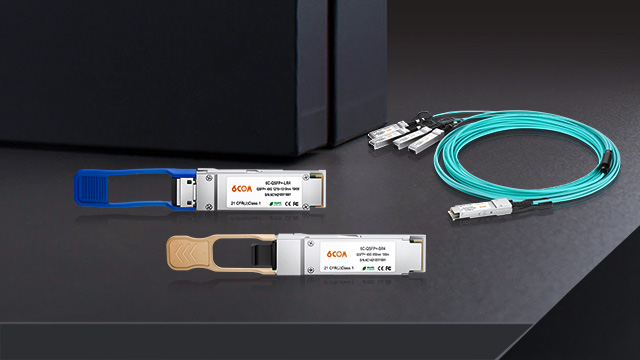Introduction
With the growing demand for high-speed data transmission within data centers and enterprise networks, the need for efficient and reliable connectivity solutions has increased. The 40GBASE-SR4 optical module has become a crucial component for short-range high-speed networking, providing cost-effective and high-performance data transmission over multimode fiber (MMF). Designed for intra-data center communication, the 40GBASE-SR4 module supports high-bandwidth applications with low latency and energy efficiency. In this article, we will explore its key features, applications, comparisons with other 40G optical modules, and best practices for selecting the right module for various networking needs.
What is the 40GBASE-SR4 Optical Module?
The 40GBASE-SR4 optical module is a high-speed transceiver that enables 40 Gigabit Ethernet transmission over multimode fiber. Based on the IEEE 802.3ba standard, it operates using four parallel optical lanes, each transmitting and receiving data at 10Gbps, resulting in a combined data rate of 40Gbps. Unlike long-range modules that rely on single-mode fiber, the SR4 module is optimized for short-range communication, supporting transmission distances of up to 100 meters over OM3 MMF and 150 meters over OM4 MMF. It uses parallel optics technology, transmitting data simultaneously across multiple fiber strands, which enhances speed and reduces latency. The module typically comes in the QSFP+ form factor, ensuring compatibility with a wide range of network switches and routers.
Key Features and Benefits
One of the primary advantages of the 40GBASE-SR4 module is its high-speed, short-range transmission capability, making it ideal for data center interconnects, high-performance computing (HPC) environments, and enterprise networks. Since it operates over multimode fiber, it offers a cost-effective solution compared to single-mode fiber transceivers, which are generally more expensive. Additionally, the SR4 module utilizes parallel optics, enabling high data throughput while maintaining low power consumption. Another key benefit is its scalability, as it allows seamless migration from 10G to 40G Ethernet using breakout cables that convert a single 40G connection into four 10G connections. Its low latency and high bandwidth efficiency further enhance overall network performance.
Applications of 40GBASE-SR4 in Networking
The 40GBASE-SR4 module is widely used in networking environments that require high-speed data transmission over short distances. One of its primary applications is in data centers, where it connects top-of-rack (ToR) switches to aggregation switches, providing seamless and high-bandwidth connectivity between different servers. Cloud computing environments also leverage the 40GBASE-SR4 module to enable high-speed communication within the infrastructure, ensuring smooth data flow for virtualized workloads. In enterprise networks, it is deployed in high-speed campus and backbone connections, supporting bandwidth-intensive applications such as video conferencing, cloud-based services, and big data processing. Additionally, financial institutions and research facilities utilize the SR4 module for low-latency, high-frequency trading, and parallel computing applications, where speed and reliability are crucial.
Comparison with Other 40G Optical Modules
When evaluating the 40GBASE-SR4 module, it is essential to compare it with other 40G optical transceivers to determine its suitability for specific applications. The 40GBASE-LR4 module, for instance, is designed for long-range communication, supporting distances of up to 10 kilometers over single-mode fiber, making it a better fit for metro and enterprise backbone networks. Meanwhile, 40GBASE-ER4 extends transmission up to 40 kilometers, but comes at a higher cost due to its additional optical amplification and signal processing requirements. Another alternative is the 40GBASE-CSR4, an extended version of the SR4 module that supports distances of up to 300 meters over multimode fiber, offering a greater range for intra-data center applications. Choosing the right module depends on factors such as distance, cost, and network topology, with the SR4 module being an optimal choice for short-range, high-speed data center connections.
Choosing the Right 40GBASE-SR4 Module
Selecting the right 40GBASE-SR4 module requires careful consideration of various factors to ensure seamless network integration. One of the primary aspects to evaluate is hardware compatibility, as different network equipment vendors may have proprietary firmware that affects transceiver functionality. Organizations must decide between OEM-branded modules and third-party compatible alternatives, with third-party options often providing significant cost savings without sacrificing performance. Another important factor is power efficiency, as lower power consumption contributes to reduced operational costs and improved data center sustainability. Additionally, proper installation and maintenance—such as cleaning fiber connectors, ensuring correct polarity in fiber patching, and monitoring signal integrity—are crucial for maintaining consistent performance and minimizing downtime. By considering these factors, businesses can optimize their network infrastructure for both performance and cost-effectiveness.
Conclusion
The 40GBASE-SR4 optical module is a vital component in high-speed, short-range networking, offering exceptional performance, scalability, and cost efficiency for data centers and enterprise networks. With its support for up to 150 meters over multimode fiber, parallel optics technology, and low power consumption, it serves as an ideal solution for high-bandwidth intra-data center connectivity. While alternative modules like 40GBASE-LR4 and 40GBASE-ER4 cater to long-distance applications, the 40GBASE-SR4 remains one of the most widely adopted transceivers for short-range networking. By carefully selecting the right module and ensuring proper deployment, organizations can achieve seamless and high-performance network connectivity that meets the demands of modern digital infrastructure. As the need for scalable, high-speed data transmission continues to grow, the role of the 40GBASE-SR4 module will remain crucial in supporting next-generation networking environments.



